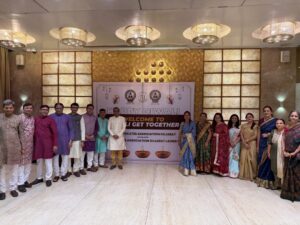GST WEEKLY UPDATE : 14/2022-23 (03.07.2022) by CA Vipul Khandhar

-By CA Vipul Khandhar
- GSTN enabled a new feature to show return filing frequency on GST Portal:
Now you can check the return filling frequency of any GST registered person. This feature will help you to identify the Quarterly Returns Monthly Payment (“QRMP”) and Non QRMP dealers. You can check the frequency of the current as well as for the previous financial year.
Steps are as follows:
- Go tohttps://services.gst.gov.in/services/searchtp
- Enter the GSTIN for which you want to check the frequency and enter the captcha
- Go to the bottom of the page and click on ‘Show Return Filling Frequency’
- GSTN removes Negative Liability/Balance from the Cash Ledger for Composition Taxpayers:
“Due to the reversal of amount in the cash ledger of some composition taxpayers, the balance in the cash ledgers had become negative. The government has now decided that the negative balance in the cash ledgers of such taxpayers should be nullified. Accordingly, the negative balance has been nullified. All such taxpayers have been informed through email also.”
- Changes in GSTR-3B return:
1) CBIC has introduced a new table 3.1.1 in which taxpayers will be required to provide details about supplies made through e-commerce operators (ECO), where such ECO pays tax on reverse charge basis.
2) Part B and part D of table 4 has also been amended. Part B deals with reversal of ITC and part D deals with reporting of ITC which does not affect ITC eligibility. 3) Part B and part D of table 4 now reads as –
(B) ITC reversed
(i) As per rules 38, 42 and 43 of CGST Rules and sub-section (5) of section 17
(ii) Others
(D) Other details
(i) ITC reclaimed which was reversed under Table 4(B)(2) in earlier tax period
(ii) Ineligible ITC under section 16(4) and ITC restricted due to PoS provisions
- GSTR-9 changes in returns:
The government has now prescribed the form GSTR-9 for FY 2021-22 The form is the same except for the following changes.
- The Non-GST supply has to be reported separately.
- The nil-rated supplies and exempted supplies can be clubbed and be reported in exempted supplies only.
- Now filing of it shall be mandatory to report HSN code at six digits level for taxpayers having annual turnover in the preceding year above ₹ 5.00 Cr and at four digits level for all B2B supplies for taxpayers having annual turnover in the preceding year up to ₹ 5.00 Cr.
- Other Changes:
- GST PMT-03A Prescribed the form for the order for re-credit of the amount to the electronic credit ledger.
- GST PMT-09 The form has been amended to make the transfer of balance n the electronic cash ledger between 2 GSTNs having the same PAN
- GST RFD-01 Added FOB value for refund claimed on the export of goods with and without payment of tax
- Gist of new notification
(1) 09/2022 – Central Tax:
i)Allows the registered person (RP) to transfer any amount available in the electronic cash ledger inter head & intra head and within distinct persons having the same PAN. The transfer would not be possible if the RP has any unpaid liability in the electronic liability ledger.
ii)W.e.f 01.07.2022 :This section states that the interest must only be charged on the amount of ITC claimed and utilized and not on mere claiming of input tax credit.
(2) 10/2022 – Central Tax:
Exempts RPs whose aggregate turnover in the Financial year 2021-22 is up to two crore rupees from the filing of annual return in form GSTR-9 for the FY 2021-22.
(3) 11/2022 – Central Tax:
Extends the due date for making payment of tax for composition persons in Form GST CMP-08 for Q-1 of the FY 2022-23 from 18.07.2022 to 31.07.2022.
(4) 12/2022 – Central Tax:
Extension of waiver of late fees till 28.07.2022 for delay in furnishing of form GSTR-4 for FY 2021-22[Annual return for composition scheme]
(5) 13/2022 – Central Tax:
Excludes the time period from 1st March 2020 to 28th Feb 2022 for computation of period of limitation for filing refund application under Section 54 of the CGST Act 2017.
(6) 14/2022 – Central Tax: Change in Invoicing Rules:
New clause “(s)” is inserted under Rule 46 of CGST Rules which state that service provider whose aggregate turnover exceed the threshold limit in any financial year from 2017-18 onwards required for raising e-invoice but are not required to raise it (not required to comply with e-invoice provisions), needs to insert the below declaration in their tax invoice:
“I/We hereby declare that though our aggregate turnover in any preceding financial year from 2017-18 onwards is more than the aggregate turnover notified under sub-rule (4) of rule 48, we are not required to prepare an invoice in terms of the provisions of the said sub-rule.”
Hence, in light of the above, SEZ Units, Banks, NBFCs and Insurance Companies now need to mandatorily include the above declaration in their tax invoice.
- Correct filling GSTR-1 and Form GSTR-3B advisory (Circular No. 170/02/2022-GST) Mandatory Furnishing of correct and proper information in return in Form GSTR-3B and statement in Form GSTR-1
Furnish correct and proper information of inter-state supplies and amount of ineligible/blocked ITC and reversal thereof.
- The guidelines stated in the circular are –
- a) Inter-state supplies made to unregistered person shall be reported place of supply wise in Table 3.2 of Form GSTR-3B and Table-7B or Table 5 or Table 9/10 of Form GSTR-1.
- b) Inter-state supplies made to composite dealers shall be reported place of supply wise in Table 3.2 of Form GSTR-3B and Table-4A or Table 4C or Table 9 of Form GSTR-1.
- c) Registered person shall update their customer database properly with correct state name and ensure that correct POS is declared in tax invoice and relevant returns.
- d) Total ITC – eligible as well as ineligible as per Form GSTR-2B, shall be reported in different fields of table 4A in Form GSTR-3B.
- e) Reversal of ITC which are absolute in nature and non-reclaimable shall be reported in table 4 (B) (1) of Form GSTR-3B.
- The ITC shall be reported –
- i) Rule 38 (reversal of credit by a banking company or a financial institution)
- ii) Rule 42 (reversal on input and input services on account of supply of exempted goods or services)
iii) Rule 43 (reversal on capital goods on account of supply of exempted goods or services)
- iv) Ineligible / blocked ITC under section 17(5) of the CGST Act.
- Reversal of ITC which are not permanent and can be reclaimed, subject to specific conditions, shall be reported in table 4 (B) (2) of Form GSTR-3B.
- ITC reporting-
- i) Rule 37 (non-payment of consideration to supplier within 180 days)
- ii) Section 16(2)(b) (non-receipt of goods or services in relevant tax period)
iii) Section 16(2)(c) (tax has not been paid by the supplier)
- iv) Reversal of any ITC availed in previous tax periods because of some inadvertent mistake.
- In part D of table 4, the taxpayer shall disclose such details which do not have bearing on the ITC that will be credited to the Electronic Credit Ledger. The following shall be reported in part D of table 4 of Form GSTR-3B-
- i) ITC reclaimed which was reversed under Table 4(B)(2) in earlier tax periods as mentioned in point (f) above.
- ii) Ineligible ITC under section 16(4) – where ITC becomes ineligible on account of limitation of time period (30th September of the subsequent year)
iii) ITC restricted due to PoS provisions (where recipient of intra-state supply is located in different state / UT than that of place of supply)
- Circular No. 171/02/2022- The circular clarified the following issues relating to FAKE invoice:
Issue No 1
(a) “A” issued tax invoice to “B” without any underlying supply of goods or services or both, whether such transaction will be covered as “supply”
(b) Whether any demand and recovery can be made from ‘A’ in respect of the said transaction under section 73/74 of Act
(c) Whether any penal action can be taken against ‘A’ in such cases.
Clarification
Since there is only issuance of tax invoice by ‘A’ to ‘B’ without supply of goods or services or both, therefore, such an activity does not satisfy the criteria of “supply”.
As there is no supply by ‘A’ to ‘B’ in respect of such tax invoice, no tax liability arises against ‘A’ for the said transaction, and accordingly, no demand and recovery is required to be made against ‘A’ under the provisions of section 73 or section 74 of CGST Act in respect of the same.
The A shall, however, be liable for penal action under section 122 (1)(ii) of the CGST Act for issuing tax invoices without actual supply of goods or services or both.
Issue No 2
“A” has issued tax invoice to “B” without supply of goods/services. ‘B’ avails GST input on the basis of the said tax invoice. B further issues invoice along with underlying supply of goods or services or both to his buyers and utilizes ITC availed on the basis of the above mentioned invoices issued by ‘A’, for payment of his tax liability in respect of his said outward supplies.
Whether ‘B’ will be liable for the demand and recovery of the said ITC, along with penal action, under section 73 or section 74 or any other provisions of the CGST Act.
Clarification
Since ‘B’ has availed and utilized fraudulent ITC on the basis of the tax invoice issued by “A”, without receiving the goods or services or both, in contravention of the provisions of section 16(2)(b) of CGST Act, he shall be liable for the demand and recovery of the said ITC, along with penal action, under section 74 of the CGST Act.
Further, as per section 75(13) of Act, if penal action for fraudulent availment or utilization of ITC is taken against ‘B’ under section 74 of CGST Act, no penalty for the same act, i.e. for the said fraudulent availment or utilization of ITC, can be imposed on ‘B’ under any other provisions of CGST Act, including under section 122.
Issue No 3
‘A’ issued tax invoice to ‘B’ without supply of goods or services or both. ‘B’ avails GST input on A’s invoice and further passes on the said GST input to ‘C’ by issuing invoices without underlying supply of goods or services or both.
Whether ‘B’ will be liable for the demand and recovery and penal action, under the section 73 or section 74 or any other provisions of the CGST Act.
Clarification
No supply of goods or services or both by ‘B’ to ‘C’, no tax was required to be paid by ‘B’ in respect of the same.
The input tax credit availed by ‘B’ in his electronic credit ledger on the basis of tax invoice issued by ‘A’, without actual receipt of goods or services or both, is ineligible in terms of section 16 (2)(b) of the CGST Act.
Therefore, in these specific cases, no demand and recovery of either input tax credit wrongly/ fraudulently availed by ‘B’ in such case or tax liability in respect of the said outward transaction by ‘B’ to ‘C’ is required to be made from ‘B’ under the section 73 or section 74 of CGST Act.
However, in such cases, ‘B’ shall be liable for penal action both under section 122(1)((ii) and section 122(1)(vii) of the CGST Act, for issuing invoices without any actual supply of goods and/or services as also for taking/ utilizing input tax credit without actual receipt of goods and/or services
Disclaimer:
This publication contains information for general guidance only. It is not intended to address the circumstances of any particular individual or entity. Although the best of endeavour has been made to provide the provisions in a simpler and accurate form, there is no substitute to detailed research with regard to the specific situation of a particular individual or entity. We do not accept any responsibility for loss incurred by any person for acting or refraining to act as a result of any matter in this publication.





